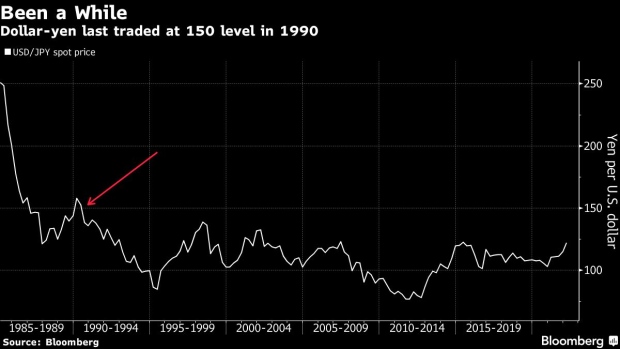Mar 24, 2022
Yen’s Unraveling Risks Collapse to 1990 Level as Traders Pile On
, Bloomberg News

(Bloomberg) -- The yen -- already seen by many as undervalued as it trades around a six-year low against the dollar -- has scope to plunge even more and could drop by close to a fifth from current levels to reach a mark unseen since the last century.
That’s the view of Societe Generale SA strategist Albert Edwards, who reckons that the unraveling of the Japanese currency, which reached 122.34 per dollar on Thursday, has the potential to take it to around 150 “as traders get the bit between their teeth.” The yen’s depreciation could also have knock-on implications across the region and help spur further depreciation of China’s currency, according to Edwards.
“When the yen breaks, it moves sharply,” he wrote in a note to clients. “Despite being incredibly undervalued and oversold, the yen could yet plunge from here as FX traders, stupefied into boredom by the lack of FX volatility in recent years, see the yen’s decline as a trading opportunity and climb aboard.”
The dollar-yen pair has soared recently, fueled in large part by climbing Treasury rates as traders adjust to an increasingly hawkish Federal Reserve that’s seeking to curb skyrocketing inflation. The yen, meanwhile, has also been kept in check by a relatively dovish Bank of Japan, which shows little inclination toward raising interest rates even as the fallout from the Ukraine war on commodity markets fuels price gains around the world.
On top of that, the yen has also lost some of its luster as a haven, meaning that it’s not even really benefiting much from periodic bouts of risk aversion that the war has prompted.
The yen has slipped around 6% versus the dollar in 2022 and is the worst performer among developed-market currencies. On Thursday, the Japanese currency continued its slide and touched a fresh six-year low, as the dollar-yen pair pushed through 122.
Given that moves tend to be sharp for the currency when it does decline, a depreciation to the 150 per dollar mark isn’t out of the question, according to Edwards. A move to that level, which hasn’t been breached since 1990, would mark a decline in the yen of more than 18% from Thursday’s low.
Further weakening of the yen potentially has major implications for East Asia’s largest economy too. Faced with a weakening currency of a major regional competitor, China may look to devalue its own currency, Edwards said.
The yuan is already under pressure, with the People’s Bank of China last week making a push to weaken the currency through its fixings and the prospects for further monetary easing there are growing. Add to that a resurgence of Covid lockdowns and concerns about growth, and the so-called renminbi, as the Chinese currency is also known, could well have room to go lower.
“The super weak yen of 2013-15, by driving down other competing Asian currencies, ultimately led us to the August 2015 renminbi devaluation,” Edwards wrote. “And once again, a weak yen is leaving the renminbi looking increasingly overvalued.”
©2022 Bloomberg L.P.






